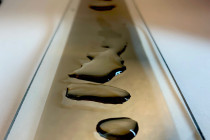As the global pursuit for sustainable energy solutions intensifies, water splitting remains a promising avenue for producing clean hydrogen fuels. But the process to split water into hydrogen and oxygen is inherently inefficient — requiring significantly more energy than theoretically predicted.
Now, Northwestern University chemists have found a molecular-level explanation for this discrepancy. In the crucial moment before giving up oxygen atoms, the water molecules perform an unexpected trick: They flip.
After observing the water molecules flip, the team quantified the precise energy cost associated with that critical step. They discovered the acrobatic act is a major contributor to water splitting’s efficiency bottleneck. But, in yet another discovery, they found increasing the pH of water lowers that energy cost and thereby contributes to making the process more efficient.
This new knowledge could help researchers find new ways to reduce the energy barrier for generating clean hydrogen fuel and for producing breathable oxygen during future missions to Mars.
The study was published today (April 15) in the journal Nature Communications.
“When you split water, two half-reactions occur,” said Northwestern’s Franz Geiger, who led the study. “One half-reaction produces hydrogen and the other produces oxygen. The half-reaction that produces oxygen is really difficult to perform because everything has to be aligned just right. It ends up taking more energy than theoretically calculated. If you do the math, it should require 1.23 volts. But, in reality, it requires more like 1.5 or 1.6 volts. Providing that extra voltage costs money, and that’s why water splitting hasn’t been implemented at a large scale. We argue that the energy required to flip the water is a significant contributor to needing this extra energy. By designing new catalysts that make water flipping easier, we could make water splitting more practical and cost-effective.”
Geiger is the Charles E. and Emma H. Morrison Professor of Chemistry at Northwestern’s Weinberg College of Arts and Sciences and member of the International Institute for Nanotechnology and the Paula M. Trienens Institute for Energy and Sustainability. The study’s lead author is Raiden Speelman and second author is Ezra J. Marker, who are both members of Geiger’s lab. Other coauthors include Alex Martinson from Argonne National Laboratory and Mavis Boamah, Jacob Kupferberg, Mark Engelhard, Yatong Zhao and Kevin Rosso — all from the Pacific Northwest National Laboratory.
Water splitting’s promise and challenges
As the climate continues to warm, scientists have become increasingly interested in water splitting as a way to produce clean hydrogen energy as an alternative to fossil fuels. To perform the process, scientists add water to an electrode and then apply a voltage. This electricity splits water molecules into two components — hydrogen and oxygen — without any unwanted byproducts. From there, researchers can collect hydrogen for fuel or repurpose the hydrogen and oxygen into energy-efficient fuel cells.
By designing new catalysts that make water flipping easier, we could make water splitting more practical and cost-effective.”
chemist
“Iridium only comes to Earth from meteoric impact, like the famous iridium anomaly at the Cretaceous-Paleogene boundary, so there’s a limited amount,” he said. “It’s very expensive and certainly not going to help solve the energy crisis any time soon. Researchers are looking at alternatives, like nickel and iron, and we’re hoping to find ways to make these materials just as efficient — if not more efficient — than iridium.”
‘Optical equivalent to noise-canceling headphones’
In the new study, Geiger and his team focused on hematite, an inexpensive and earth-abundant iron oxide mineral. Although hematite is a promising material for performing the OER, it suffers from inefficiency — much like other inexpensive metals. To explore the reason why, the researchers applied a sophisticated new light-based technique called phase-resolved second harmonic generation (PR-SHG).
Previously developed in Geiger’s laboratory, PR-SHG enables researchers to observe how water molecules interact with the metallic electrode in real time. To conduct the experiment, the team first placed a hematite electrode into a special container with water. Then, they shined a laser onto the electrode’s surface and measured the light intensity at half the wavelength. Using multiple optical components — including lenses, mirrors and crystals — the researchers manipulated the laser beam to gain detailed information.
“Our technique is the optical equivalent to noise-canceling headphones,” Geiger said. “We can essentially control constructive and deconstructive interference — the photon's phase — and, from that, we can precisely quantify how many water molecules are pointing to the surface and how many rearrange to point away from it.”
By analyzing the amplitude and phase of the signal photons, Geiger’s team inferred the water molecules’ arrangement. Before applying the voltage, the researchers noticed the water molecules were randomly positioned. As they applied a precise voltage to the electrode, however, they watched the water molecules reorient themselves.
Quantifying the energy hurdle
Directly observing the water molecules flip enabled the researchers to measure how many water molecules flipped as well as the energy associated with that flipping. They found the flipping happens immediately before OER starts, indicating this is a necessary, non-negotiable step in the process.
“These electrodes are negatively charged, so the water molecule wants to put its positively charged hydrogen atoms toward the electrode’s surface,” Geiger said. “In that position, electron transfer — from water's oxygen atoms to the electrode's active site — is blocked. We find that when the electric field becomes strong enough, it causes the molecules to flip, so the oxygen atoms point toward the electrode’s surface. Then, the hydrogen atoms are out of the way, and the electrons can move from water's oxygen to the electrode.”



